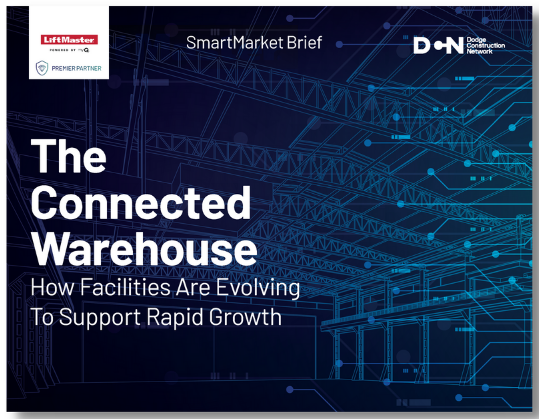by Brianna Crandall — April 1, 2022 — Dodge Construction Network, in partnership with LiftMaster, recently released a new SmartMarket Brief entitled The Connected Warehouse that focuses on the rapidly growing market for sophisticated and technologically connected warehouse/distribution centers in the U.S.
Dodge is currently forecasting $53 billion of construction starts in the U.S. warehouse/distribution center market in 2022, up 1400% since 2010 and representing over one-third (36%) of the entire U.S. commercial construction sector this year.
Driven by strong consumer demand in the economy and the explosion of e-commerce retailing, these facilities are deploying sophisticated technologies to optimize performance and respond to changing demands. In addition, they are round-the-clock workplaces for a growing number of employees and require increasing levels of energy, security and safety management.
Based on a survey of several hundred industry professionals who create these facilities, the report addresses investment drivers, locational trends, deployment of connected technologies, worker safety and amenities, sustainability initiatives and ways in which design and construction are adapting to support these dynamic needs.
Jenny Lytle, general manager, Commercial Emerging Business, at LiftMaster, commented:
LiftMaster is pleased to work with Dodge on this important research. Managing a warehouse with multiple access points and loading docks can be a stressful and demanding job; any inefficiencies can result in increased expenses or safety issues. LiftMaster has installed connected gates, doors, and docks and myQ Facility and Dock Management software within warehouse/distribution centers across the United States.
We have seen firsthand how our cloud-based solutions have provided warehouse managers with an easier way to monitor warehouse doors and docks and collect real-time insight around daily operations, enabling them to make smarter, data-driven decisions. We hope that sharing these key findings across the industry will accelerate the advancement of these critical facilities and provide a baseline for future studies to track progress.
Key findings include:
- Investments are driven by the need for flexibility to accommodate higher volumes and changing business models. Fluctuating demand, rapidly changing product lines and evolving business models such as On-Demand Warehousing are driving the need to invest in retrofits and new projects.
- Facilities are increasingly close to urban centers. All regions of the country report increases in the percentage of projects located in or near urban centers to support rapid delivery expectations from consumers.
- Connected automation systems are proliferating at loading docks. 77% of respondents report automation of operational and handling processes at loading docks on their recent projects, with as many as 88% citing use of one of the four specific systems studied.
- Connected technology systems are being deployed facility wide. In addition to the widespread automation of operational and handling processes throughout these facilities, between 60% and 82% of respondents report installation of data-capturing smart controls, A/V and light communications, and security and access control/tracking systems on their recent projects.
- Worker amenities and safety are increasingly important, especially in a tight labor market. All regions report increases in a wide variety of employee amenities, and 88% of respondents say owners place a high priority on employee safety when planning their facilities.
- Over two-thirds of owners (68%) are interested in creating zero-carbon facilities. Sustainability is important, with high percentages of owners interested in minimizing both energy use and operational waste in their facilities as well as creating zero-carbon buildings. Many are also seeking LEED certification and incorporating a wide variety of green products and materials.
- Technology is being applied to the design and construction process. Respondents report using technologies such as BIM (building information modeling), software to model energy use and software to simulate operations in the facility to be built during the design and construction process. Many studies by Dodge show that these tools can help to accelerate project delivery, control costs and achieve quality goals, so similar results can be expected in this sector as well.
Steve Jones, senior director of Industry Insights at Dodge Construction Network, remarked:
Warehouses were once seen as a quiet backwater in the overall commercial construction sector. But the market has literally exploded in the past few years, and these facilities are becoming increasingly complex and sophisticated. We are glad to have the opportunity to explore this in depth and hope the report raises industry awareness and expertise around these important elements of our economy.
The report also features an extensive interview with Tripp Eskridge, managing director of Project Management from CBRE who brings a unique perspective from more than 30 years of experience managing the design and construction process for industrial facilities such as these.
The SmartMarket Brief that contains the full findings of the Connected Warehouse study and the interview can be downloaded for free.
Dodge Construction Network offers data and analytics for the commercial construction industry and powers four longstanding industry solutions: Dodge Data & Analytics, The Blue Book Network, Sweets, and IMS.
LiftMaster manufactures residential and commercial door and gate operators, telephone entry systems, and related access control products.





